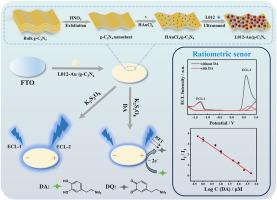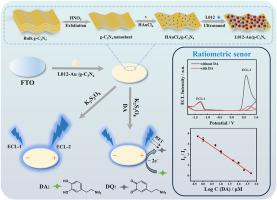In situ growth of L012-reduced gold nanoparticles-loaded graphitic carbon nitride nanocomposite for potential-resolved ratiometric electrochemiluminescence analysis
IF 5.7
2区 化学
Q1 CHEMISTRY, ANALYTICAL
引用次数: 0
Abstract
Background
Most electrochemiluminescence (ECL) analytical methods involve only changes in one single signal, which greatly limits their high sensitivity and stability for applied research. Potential-resolved electrochemiluminescence (PRECL), which provides calibrated analysis by self-correcting signal responses from dual channels, has attracted great interest in recent years. However, research on PRECL nanomaterials is still at an early stage. It is critical to develop a novel PRECL nanocomposite with high intensity in light emission, high resolution in potential separation, and reduced complexity in reaction systems for accurate detection.
Results
Here, a novel PRECL nanocomposite, L012-Au/g-C3N4, was synthesized by in situ growth of L012-reduced gold nanoparticles (L012-Au) on the surface of graphitic carbon nitride (g-C3N4) nanosheets. The g-C3N4 nanosheets served as effective carriers for L012 molecules and L012-Au, as well as efficient cathodic ECL emitters. With the addition of a single co-reactant (K2S2O8), two fully separated ECL peaks were observed around −1.3 V (ECL-1) and +0.6 V (ECL-2) at neutral conditions. The catalytic character of the incorporated gold nanoparticles accelerated the anodic ECL reaction and greatly enhanced the ECL intensity. Furthermore, an ECL mechanism based on the competitive relationship between K2S2O8 and dissolved oxygen was proposed. When dopamine (DA) was introduced into the PRECL reaction system, ECL-1 remained essentially unchanged, while ECL-2 intensity was significantly reduced. By analyzing the intensity ratio of ECL-2 to ECL-1 (I2/I1) to the detecting target, a ratiometric DA sensor with high sensitivity and stability was successfully constructed.
Significance
A nanocomposite L012-Au/g-C3N4 that can induce high-intensity ECL with two separated potentials in each polarity has been prepared by a simple synthetic method. The developed ratiometric sensor can eliminate systematic errors and improve accuracy. In addition, the multifunctionality of the nanocomposite and the necessity of only one co-reactant for neutral-condition ECL greatly reduced the reaction complexity. Our work offers new PRECL solutions to design highly sensitive and stable multi-response detection systems for in vitro diagnostics.


原位生长 L012 还原金纳米粒子负载氮化石墨碳纳米复合材料,用于电位分辨比率电化学发光分析
背景大多数电化学发光(ECL)分析方法只涉及单个信号的变化,这大大限制了其在应用研究中的高灵敏度和稳定性。电位分辨电化学发光(PRECL)通过双通道信号响应的自我校正来提供校准分析,近年来引起了人们的极大兴趣。然而,有关 PRECL 纳米材料的研究仍处于早期阶段。结果通过在氮化石墨碳(g-C3N4)纳米片表面原位生长 L012 还原金纳米粒子(L012-Au),合成了一种新型 PRECL 纳米复合材料 L012-Au/g-C3N4。g-C3N4 纳米片是 L012 分子和 L012-Au 的有效载体,也是高效的阴极 ECL 发光体。加入单一共反应物(K2S2O8)后,在中性条件下可观察到两个完全分离的 ECL 峰,分别在 -1.3 V(ECL-1)和 +0.6 V(ECL-2)左右。金纳米粒子的催化特性加速了阳极 ECL 反应,大大提高了 ECL 强度。此外,还提出了一种基于 K2S2O8 与溶解氧之间竞争关系的 ECL 机制。当在 PRECL 反应体系中引入多巴胺(DA)时,ECL-1 基本保持不变,而 ECL-2 的强度则显著降低。通过分析 ECL-2 与 ECL-1 的强度比(I2/I1)与检测目标的关系,成功构建了一种高灵敏度和高稳定性的 DA 比率传感器。所开发的比率传感器可消除系统误差并提高准确度。此外,纳米复合材料的多功能性以及中性条件 ECL 只需一种共反应物的特点大大降低了反应的复杂性。我们的工作为体外诊断设计高灵敏度和稳定的多反应检测系统提供了新的 PRECL 解决方案。
本文章由计算机程序翻译,如有差异,请以英文原文为准。
求助全文
约1分钟内获得全文
求助全文
来源期刊

Analytica Chimica Acta
化学-分析化学
CiteScore
10.40
自引率
6.50%
发文量
1081
审稿时长
38 days
期刊介绍:
Analytica Chimica Acta has an open access mirror journal Analytica Chimica Acta: X, sharing the same aims and scope, editorial team, submission system and rigorous peer review.
Analytica Chimica Acta provides a forum for the rapid publication of original research, and critical, comprehensive reviews dealing with all aspects of fundamental and applied modern analytical chemistry. The journal welcomes the submission of research papers which report studies concerning the development of new and significant analytical methodologies. In determining the suitability of submitted articles for publication, particular scrutiny will be placed on the degree of novelty and impact of the research and the extent to which it adds to the existing body of knowledge in analytical chemistry.
 求助内容:
求助内容: 应助结果提醒方式:
应助结果提醒方式:


